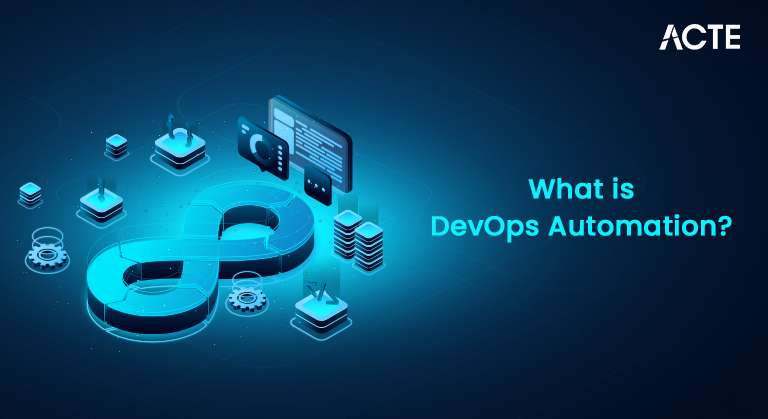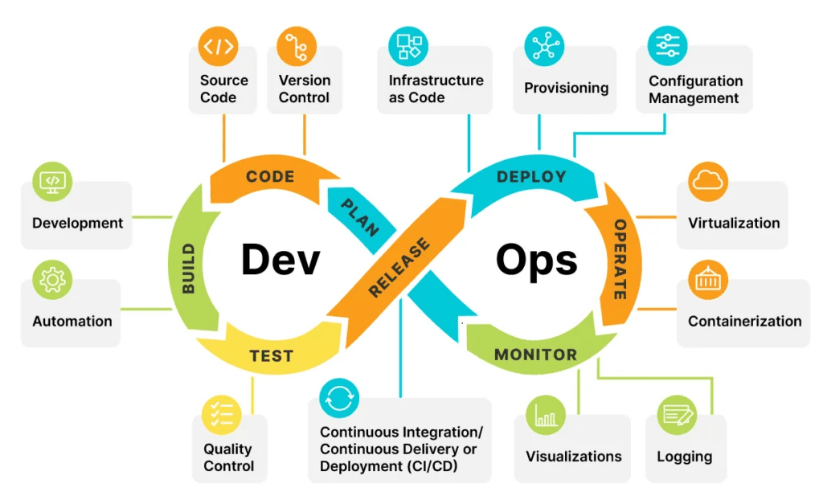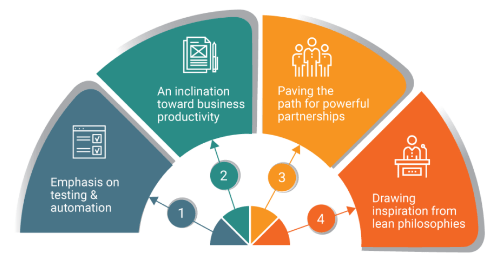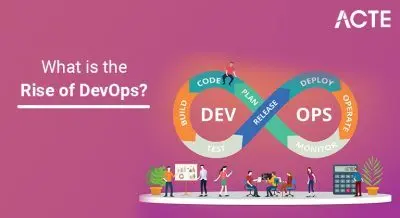
- Introduction to DevOps
- Evolution of DevOps in IT Industry
- Key Principles of DevOps
- DevOps vs Agile: Differences and Similarities
- DevOps Tools and Technologies
- CI/CD in DevOps Explained
- Infrastructure as Code (IaC) Overview
- DevOps in Cloud Computing
- Measuring the Success of DevOps in an Organization
- Future Trends in DevOps
Introduction to DevOps
DevOps is a set of practices, tools, and cultural philosophies that aim to improve collaboration and productivity between software development (Dev) and IT operations (Ops). The core purpose of DevOps is to shorten the software development lifecycle, automate the processes of software delivery, and improve the quality of software. By encouraging collaboration between traditionally siloed teams, DevOps Training helps organizations deliver applications and services at a faster pace, with more stability and security. DevOps Automation has become increasingly essential in today’s fast-paced digital world, where businesses need to quickly respond to market demands, adapt to changing technologies, and maintain high-quality user experiences. This methodology focuses on continuous integration, continuous deployment (CI/CD), automation, infrastructure as code (IaC), and feedback loops to enable rapid, safe, and reliable software development.
Want to Earn Your DevOps Certification? Check Out DevOps Online Course Offered By ACTE Right Now!
Evolution of DevOps in the IT Industry
The evolution of DevOps is rooted in the need for better alignment between development and operations teams. Before DevOps, the software development lifecycle was often divided into two distinct silos: development and operations. What is Continuous Integration in Jenkins can be better understood by examining past challenges where the development team focused on creating the software, while the operations team was responsible for deploying and maintaining it. This separation often led to inefficiencies, communication breakdowns, and delays. DevOps emerged in the mid-2000s as a response to these challenges. The term “DevOps” was coined by Patrick Debois in 2009, following discussions on the difficulties that developers and operations teams faced when working together.

Initially, DevOps was a cultural shift that focused on breaking down silos, improving collaboration, and fostering shared responsibility for the entire lifecycle of an application. Over time, DevOps has grown to incorporate various tools and technologies that automate processes and improve collaboration. As cloud computing, containerization, and microservices architecture gained popularity, DevOps methodologies were integrated with these technologies to enable scalable, flexible, and more efficient software development and operations.
Using Infrastructure as Code (IaC)
Infrastructure as Code (IaC) is a key practice in DevOps that allows teams to manage and provision computing infrastructure through code rather than manual processes.
- Collaboration and Communication: DevOps emphasizes the importance of collaboration and communication between development and operations teams. Shared goals, responsibilities, and workflows are critical to the success of DevOps initiatives.
- Automation: Automating manual tasks is a central tenet of DevOps. Automation reduces errors, speeds up the development and deployment cycles, and ensures consistency across environments. Commonly automated tasks include testing, integration, deployment, and configuration management.
- Continuous Integration and Continuous Deployment (CI/CD): CI/CD is a fundamental DevOps practice. Continuous integration involves regularly merging code changes into a central repository, while continuous deployment ensures that these changes are automatically deployed to production using Top Most DevOps Security Tools to maintain security and compliance throughout the process.
- Infrastructure as Code (IaC): IaC is the practice of managing and provisioning infrastructure using code and automation tools, rather than manual processes. It allows teams to treat infrastructure in a similar way to application code, enabling consistent and repeatable deployments.
- Monitoring and Feedback: DevOps emphasizes continuous monitoring and feedback to identify performance bottlenecks, bugs, and areas of improvement. Real-time monitoring of both the application and infrastructure enables quick detection and resolution of issues.
- Security (DevSecOps): Security is a critical part of DevOps. DevSecOps integrates security practices into the development pipeline, ensuring that security is considered at every stage of the software lifecycle, from development to deployment.
- Version Control: Tools like Git (GitHub, GitLab, Bitbucket) enable version control and collaboration among development teams.
- Continuous Integration/Continuous Deployment (CI/CD): Tools like Jenkins, CircleCI, GitLab CI, and Travis CI automate the integration and deployment processes.
- Configuration Management: What is Blue Green Deployment can be better understood alongside tools like Ansible, Chef, and Puppet, which help automate infrastructure management and configuration tasks.
- Containerization: Docker and Kubernetes are popular tools for containerization and orchestration, enabling developers to package and deploy applications in consistent, isolated environments.
- Monitoring and Logging: Tools like Prometheus, Grafana, ELK Stack (Elasticsearch, Logstash, Kibana), and Datadog provide monitoring, logging, and performance insights into the application and infrastructure.
- Infrastructure as Code (IaC): Tools like Terraform and AWS CloudFormation help manage cloud infrastructure using code, allowing for automated provisioning and management.
- Popular Tools: Common tools used for implementing IaC include Terraform, AWS CloudFormation, and Ansible.
- Definition: Infrastructure as Code (IaC) is the practice of managing and provisioning IT infrastructure using machine-readable configuration files.
- Automation: IaC enables DevOps teams to automate the setup of infrastructure, eliminating the need for manual configuration.
- Version Control: With IaC, infrastructure configurations can be versioned just like application code, enabling better tracking and rollback capabilities contributing to the Rise of DevOps in modern software development practices.
- Consistency: IaC ensures consistent environments across development, testing, and production by using standardized configuration files.
- Declarative Provisioning: Teams can define infrastructure components such as servers, storage, and networks in a declarative format.
- Benefits: IaC reduces configuration errors, speeds up infrastructure provisioning, and supports scalability, making it a critical part of modern DevOps workflows.
- Deployment Frequency: How often code is deployed to production.
- Change Failure Rate: The percentage of deployments that result in failures.
- Lead Time for Changes: The time it takes to go from code commit to production deployment.
- Mean Time to Recovery (MTTR): AWS DevOps Tools for Cloud Build and Deployment determine how quickly the organization can recover from a failure or issue in production.
- Customer Satisfaction: Improvements in customer experience due to faster releases and higher-quality software.
- Code Quality: Measures the quality of the code being deployed, including defect rates and technical debt.
- Team Velocity: The amount of work a team completes in a given period, often measured by story points or tasks completed.
- Resource Utilization: Efficiency in using cloud or infrastructure resources, indicating the ability to deliver software with optimized cost and performance.
Earn Your DevOps Certification, Gain Insights From Leading DevOps Experts And Advance Your Career With ACTE’s DevOps Online Course Today!
DevOps vs Agile: Differences and Similarities
While both Agile and DevOps aim to enhance the software development process, they differ in their focus and execution but share several core principles. One major similarity is collaboration Agile encourages close collaboration among development teams, while DevOps extends this collaboration to include operations teams, fostering a more unified workflow. Both also employ an iterative approach, where Agile uses short development sprints to deliver small, functional increments of software, and DevOps Training supports continuous integration and continuous delivery (CI/CD) pipelines to enable ongoing deployment. Furthermore, both methodologies are customer-centric, emphasizing the importance of delivering value to end-users quickly, frequently, and consistently. However, Agile and DevOps differ in scope and responsibility.

Agile is primarily focused on the development side of the software lifecycle, aiming to break down projects into manageable pieces with continuous feedback loops. DevOps takes a broader view, covering the entire software delivery lifecycle from development to deployment and maintenance ensuring seamless integration and reliability. In terms of feedback loops, Agile emphasizes input from stakeholders and product owners to refine features, whereas DevOps collects feedback from both development and operational environments to improve system performance, deployment efficiency, and infrastructure reliability. Together, Agile and DevOps can complement each other to deliver robust, scalable, and high-quality software faster.
DevOps Tools and Technologies
There are many tools and technologies available to help implement and manage DevOps practices. Some of the most popular tools include:
CI/CD in DevOps Explained
Continuous Integration (CI) and Continuous Deployment (CD) are fundamental DevOps practices that streamline software development and delivery through automation. Continuous Integration (CI) involves the frequent merging of code changes from multiple developers into a shared repository, often several times a day. This approach helps detect integration issues early and ensures the codebase remains functional and deployable. Automated tests are run as part of the CI process to maintain code quality and prevent bugs from entering the main branch, highlighting Why DevOps and What it Means for Federal Agencies in ensuring reliable and secure software delivery. Continuous Deployment (CD) takes automation a step further by deploying code changes directly to production after successful testing in the CI pipeline. This eliminates the need for manual deployment steps, resulting in faster, more reliable software releases. Together, CI/CD enhances development speed, reduces human error, and enables rapid feedback and iteration. By automating the entire workflow from code commit to production release, CI/CD has become a cornerstone of modern DevOps practices, supporting agile development and continuous delivery of value to users.
Want To Pursue a DevOps Master’s Degree? Enroll For DevOps Masters Course Today!
Infrastructure as Code (IaC) Overview
DevOps in Cloud Computing
DevOps and cloud computing complement each other, creating an ideal environment for rapid and efficient software development and delivery. Cloud platforms such as AWS, Microsoft Azure, and Google Cloud provide the essential tools and infrastructure that support key DevOps practices like automation, continuous integration/continuous deployment (CI/CD), and monitoring. These platforms enable DevOps teams to quickly provision resources, scale applications as needed, and take advantage of managed services that reduce the burden of maintaining physical hardware. Additionally, cloud environments support containerization and orchestration tools like Docker and Kubernetes, which streamline deployment and scaling processes, especially when integrated with DevOps Tools for Database Management. The flexibility and scalability offered by the cloud allow for faster iteration, improved collaboration, and more reliable application performance. By leveraging cloud computing, DevOps teams can focus more on delivering value and innovation while minimizing operational complexities, making the cloud a fundamental enabler of successful DevOps adoption.
Measuring the Success of DevOps in an Organization
The success of DevOps initiatives can be measured using several key performance indicators (KPIs), including:
Go Through These DevOps Interview Questions & Answer to Excel in Your Upcoming Interview.
Future Trends in DevOps
The future of DevOps will be significantly influenced by advancements in automation, AI/ML, and continuous integration technologies. Artificial Intelligence and Machine Learning will enhance DevOps by automating processes like monitoring, anomaly detection, and predictive maintenance, improving system performance and reducing downtime. Microservices and serverless architectures will continue to expand, making DevOps practices even more crucial for managing distributed systems. DevOps Training will see increased focus on DevSecOps, integrating security into every phase of the DevOps lifecycle, with a shift towards proactive security measures to protect applications. GitOps, where infrastructure and deployment configurations are managed through Git repositories, will become more prevalent, streamlining deployment and ensuring consistency across environments. Lastly, as edge computing grows, DevOps practices will evolve to manage deployments closer to the data source, ensuring fast and reliable application performance across distributed systems. These trends will reshape DevOps, driving efficiency, security, and innovation in modern software development.




